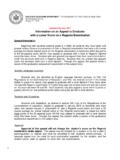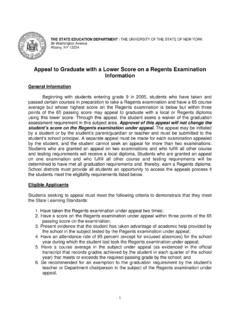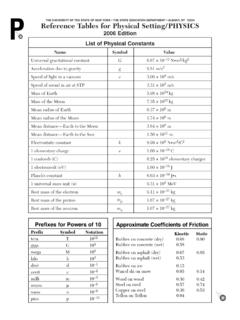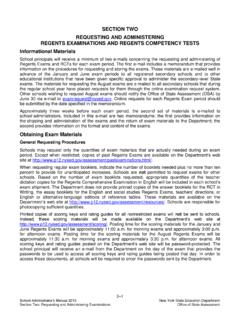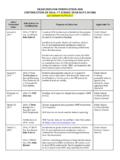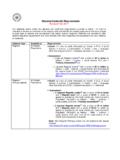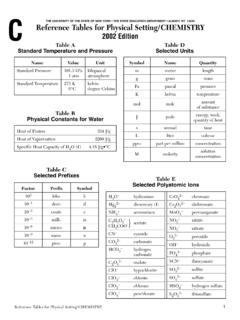Transcription of Social Emotional Learning: A Guide to Systemic Whole ...
1 Social Emotional LEARNING: A. Guide TO Systemic Whole SCHOOL. IMPLEMENTATION. A Guide TO Systemic Whole SCHOOL IMPLEMENTATION. March 2019. TABLE OF CONTENTS. Introduction .. 5. Social Emotional Learning's Five Core Competencies .. 8. SEL for Personal and Academic Success .. 9. SEL for the School .. 9. SEL for College and Career 10. SEL for Equity .. 12. Resources .. 13. SEL and Adverse Childhood Experiences (ACEs) .. 13. Resources .. 14. New York State Social Emotional Learning Goals .. 15. Systemic Whole School SEL Implementation .. 16. Resources .. 17. School Culture/School Climate and SEL .. 18. Resources .. 19. SEL and Multi-Tiered Systems of Support (MTSS) .. 19. Resources .. 20. Alignment of Current Programs that Address SEL.
2 20. Identifying an SEL Implementation Team .. 21. Developing a Shared Vision for Schoolwide SEL .. 23. Resources .. 24. Conducting a Needs and Resources Assessment .. 25. Resources .. 26. SEL and Instruction .. 26. Explicit Instruction in Social Emotional Skill Building .. 26. Resources .. 27. Integration of SEL into Content Area Lessons .. 27. Intentional Teaching Practices to Model and Reinforce Social Emotional Skills .. 28. 2|Page Resources .. 31. Aligning Afterschool, Summer School and Community School Programs with the School's SEL. Based Policies, Procedures, and Principles .. 31. Resources .. 33. Professional Development .. 34. Adult SEL .. 35. Resources .. 36. Parents and Families as Partners in SEL Implementation.
3 36. Community Building Circles .. 38. Resources .. 39. Approach to Discipline .. 40. Discipline and Data .. 40. SEL and Restorative Practices .. 40. Social Emotional Growth and Reduced Recidivism .. 42. Resources .. 42. Assessment .. 43. Using Data for Continuous Improvement .. 44. Measuring Implementation .. 45. Measuring School Climate .. 45. Measuring Adult Beliefs and Practices .. 46. Measuring Student Data .. 46. Resources .. 47. Long Term Sustainability .. 49. Resources .. 50. 51. References .. 55. Appendix A: Sample Social Emotional Implementation Rubric for Effective Planning, Implementation, and Continuous 61. Appendix B: CASEL Collaborating Districts Initiative .. 62. 3|Page Appendix C: What Does a Positive School Culture Look Like?
4 63. Appendix D: Description and Use of Restorative Practices .. 65. Appendix E: Example of a Restorative Dialogue .. 68. 4|Page INTRODUCTION. The mission of the New York State Education Department is ( ) to raise the knowledge, skill, and opportunity of all people in New York. In alignment with this mission , every public school seeks to graduate students prepared for college and career and ready for responsible citizenship in the 21st century. In addition to academic content and skill development, schools must address many contextual factors, including physical and mental health, safety, socioeconomics, culture, and the Schools should look behind focus of this guidance, Social Emotional learning classroom doors and determine the (SEL).
5 Factors that contribute to the kinds SEL is essential to creating schools that effectively of interactions between teachers prepare all students to succeed in school and in life. and students that promote student It is the process through which children, youth, and achievement. adults acquire and effectively apply the knowledge, Cognitive and character skills work attitudes, and skills necessary to understand and together as dynamic complements;. manage emotions, set and achieve positive goals, they are inseparable. Skills beget feel and show empathy for others, establish and skills. More motivated children maintain positive relationships, and make learn more. Those who are more responsible decisions (Collaborative for Academic, informed usually make wiser Social , and Emotional Learning, 2018).
6 Decisions. Systemic Whole school implementation of SEL Self-control, openness, the ability to encourages safe, supportive school communities in engage with others, to plan and to which all young people are valued. When a school's persist - these are the attributes culture is based on students' strengths, providing that get people in the door and on tiered supports as needed, all students in the school the job, and lead to productive community benefit. Each implementation lives. component addressed in the pages that follow reflects this commitment to creating and sustaining James Heckman, Nobel Laureate a school culture and climate that enables all young people to thrive. Success in this depends upon the Director, Center for the Economics collaborative efforts of all members of the school of Human Development, University community.
7 Of Chicago The New York State Education Department (SED). has for many years been involved in the development of initiatives to encourage and support the development of learning environments that are emotionally and physically healthy. A 2009. document titled Educating the Whole Child, Engaging the Whole School: Guidelines and Resources for Social and Emotional Development and Learning in New York State ( ) was adopted by the NYS Board of Regents (BOR) in July 2011. The intent of this guidance was to offer school districts compelling information, examples, and evidence of SEL in elementary and secondary education programs, 5|Page and to encourage schools to consider the importance of supporting the holistic development of young people.
8 SED's work on SEL has expanded over the years, building on this foundation. In 2013, the NYS BOR. The issue should not be framed as a and SED convened the NYS Safe Schools Task Force choice between intellectual and to consider ways to improve safety in NYS schools as Social - Emotional development, IQ. part of an initiative to produce well-educated, well- [Intelligence Quotient] and EQ. adjusted, and healthy young adults. Thirty-six [ Emotional Quotient], or academic recommendations for improving safety and learning and inter- and intrapersonal skills. were presented to the BOR by the Safe Schools Task Sound education requires an Force in 2014. One of these recommendations was equivalent focus on EQ and IQ, and the establishment of SEL benchmarks as a key all schools must deal with this component to student success and learning.
9 Reality. SED's current initiatives have built upon that Elias, Arnold, & Hussey, 2003, as previous work. As of 2018, the School Climate and cited in Elias, Arnold, & Steiger, Student Engagement Workgroup of the Safe Schools 2003, p. 308. Task Force has developed the following resources: Goals for SEL for New York State students: These three goals have been developed based on five Social Emotional competencies identified by the Collaborative for Academic, Social , and Emotional Learning (CASEL) and recognize the developmental nature of Social Emotional skills. 1. Develop self-awareness and self-management skills essential to success in school and in life. 2. Use Social awareness and interpersonal skills to establish and maintain positive relationships.
10 3. Demonstrate ethical decision-making skills and responsible behaviors in personal, school, and community contexts. Social Emotional Learning Benchmarks ( ). o These benchmarks have been developed based upon New York's three goals for SEL. Social Emotional Learning: Essential for Learning, Essential for Life ( ). o This document includes the philosophy of this framework and research behind the implementation of SEL. In addition, it includes an explanation of why SEL is vital in education and why teaching Social Emotional skills is as important to student success and learning as academic instruction. Social Emotional Learning: A Guide to Systemic Whole School Implementation o This Guide is a resource to enable schools to assess their needs and plan for Systemic implementation of SEL.
